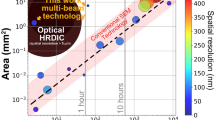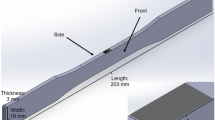Abstract
The purpose of this investigation was to study the load dependence of the microhardness, typically in the range 5–500 gf. This well known phenomena is called the indentation size effect (ISE) and was investigated for two sets of specimens: titanium and aluminium alloys. Variation of the hardness with applied load was first compared with various existing models and the surface profile, near the indent, was measured by confocal microscopy. The formation of pile-ups near the indentation print led to the correction of the indent diagonal which is found to fit well with our experimental data as well as with other results in the literature. For the materials investigated, the ISE effect is an artefact, i.e. the variation of hardness with the applied load is only a consequence of the variation of the contact surface between the specimen and the indenter.
Similar content being viewed by others
References
P. M. Sargent, in “Microindentation Techniques in Materials Sciences and Engineering”, ASTM STP 889, edited by P. J. Blau and B. R. Lawn (American Society for Testing and Materials, Philadelphia, 1986) pp. 160–174.
B. W. Mott, in “Microindentation Hardness Testing” (Butterworths, London, 1957).
H. Buckle, in “Science of Hardness Testing and Its Research Applications”, edited by J. H. Westbrook and H. Conrad (American Society for Metals, Metals Park, Ohio, 1971) ch. 33, pp. 453–491.
D. Tabor, Rev. Phys. Technol. 1 (1970) 145.
Idemin “Microindentation Techniques in Materials Science and Engineering”, ASTM STP 889, edited by P. J. Blau and B. R. Lawn (American Society for Testing and Materials, Philadelphia, 1986) pp. 129–159.
C. Hays and E. G. Kendall, Metallog. 6 (1973) 275.
H. Li and R. C. Bradt, J. Mater. Sci. 28 (1993) 917.
E. O. Bernhardt, Z. Metallkde 33 (1941) 135.
F. Fröhlich, P. Grau and W. Grellmann, Phys. Status Solidi A 42 (1977) 79.
O. Vingsbo, S. Hogmark, B. Jönsson and A. Ingermarson, in “Microindentation Techniques in Materials Science and Engineering”, ASTM STP 889, edited by P. J. Blau and B. R. Lawn (American Society for Testing and Materials, Philadelphia, 1986) pp. 257–271.
A. Thomas, Surf. Eng. 3 (1987) 117.
J. P. Riviere, P. Guesdon, G. Farges and D. Degout, Surf. Coatings Technol. 42 (1990) 81.
G. Farges and D. Degout, Thin Solid Films 181 (1989) 365.
T. Yokohata and K. Kato, Wear 168 (1993) 109.
N. A. Stelmashenko, M. G. Walls, L. M. Broxwn and Yu. V. Milman, Acta Metall. Mater. 41 (1993) 2855.
Author information
Authors and Affiliations
Rights and permissions
About this article
Cite this article
Iost, A., Bigot, R. Indentation size effect: reality or artefact?. JOURNAL OF MATERIALS SCIENCE 31, 3573–3577 (1996). https://doi.org/10.1007/BF00360764
Received:
Accepted:
Published:
Issue Date:
DOI: https://doi.org/10.1007/BF00360764




